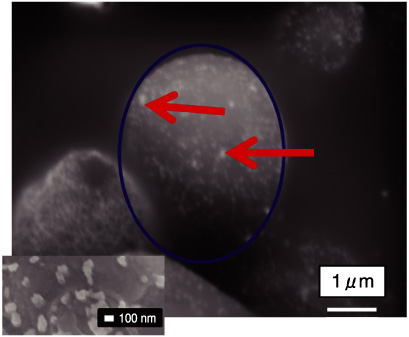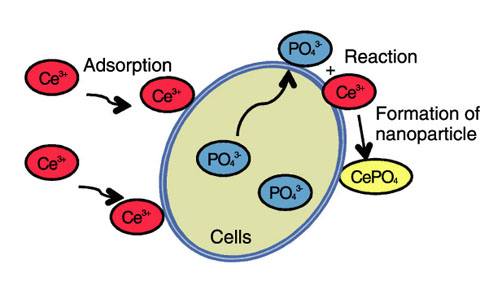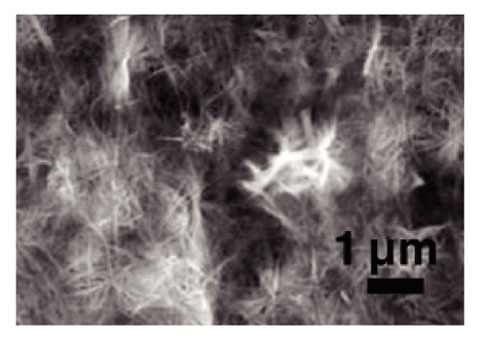
Fig.6-11 SEM photograph of yeast after exposure to cerium ions in aqueous solution for four days

Fig.6-12 Nanoparticle formation mechanism on cell surface of microorganism

Fig.6-13 Cerium phosphate precipitates formed abiotically in aqueous solution
For the metabolism, microorganisms possess various functions. Unfortunately, only a limited number of biological functions have been elucidated so far. A new biological function of a microorganism may be found by using heavy elements that are not essential elements.
We tested yeast Saccharomyces cerevisiae after exposing it to cerium ions in an aqueous solution. The concentration of cerium ions decreased with increasing exposure time, while the concentration of phosphorous increased. Electron microscopy analysis showed that many nanoscale particulates, including cerium and phosphorous, were produced on the cell surface (Fig.6-11). Since phosphorous ions were not added to the solution, the cerium ions adsorbed on the cell surface reacted with the phosphorous ions discharged from the yeast cell, and nanoparticles (Fig.6-12) were formed. Electron diffraction analysis showed that the nanoparticles formed were of monazite (CePO4), which is a rare-earth-element phosphate mineral. Although cerium phosphate was precipitated in a solution containing cerium ions and phosphoric acids in an abiotic system, the size and shape of the precipitates differed from those of the precipitates formed on the yeast cell surface (Fig.6-13). Therefore, it can be said that the yeast cell functioned like a factory that produces nanoparticles of cerium phosphate. The production of nanoparticles on the cell surface of a microorganism is a new development in biotechnology, and it differs drastically from conventional engineering techniques.
We consider the microbial cell surface to be a reaction field where the heavy metal ions outside the cell react with the essential elements released from the interior of the cell. It is thought that a microorganism will be capable of not only collecting heavy elements but also isolating a specific element from others. The biological techniques for the accumulation and selection of metal ions will be applied to the recovery and separation of actinides in the nuclear fuel reprocessing process and to the development of a mathematical model for estimating the migration of actinides in groundwater.
<Previous: 6-4 | Next: 7 Nuclear Science and Engineering Research >